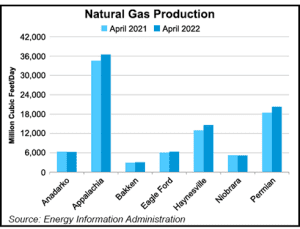New federal data confirms Appalachia will continue its production leadership well into the spring season, bolstering economic opportunities, enhancing environmental progress, and further strengthening overall energy security.
Increasing 186 million cubic feet of natural gas per day (MMcf/d), production from Pennsylvania, Ohio, and West Virginia is predicted to exceed 36,000 MMcf/d this April, nearly double the Permian’s projected growth, according to the U.S. Energy Information Administration (EIA)’s latest Drilling Productivity Report.

Pennsylvania is a linchpin in this production, ranking second among states in gas production, according to Washington County’s Observer-Reporter, producing7.6 trillion cubic feet of natural gas in 2021.
“That amount would heat 114 million homes for a year. The state is producing more than we can use. We are duty bound to help the nations of Europe,” MSC’s Callahan told the O-R.
Led by operational efficiencies and industry-adopted innovative practices, Appalachia continues to produce more energy with significantly fewer environmental impacts.
Southwestern Energy, for example, has been “Freshwater Neutral” for over 5 years, returning 14 billion gallons of water to the environment. Another Marcellus operator, Range Resources, reuses nearly 100% of produced water and recycles water used by other producers in the region.
“Our water management program and investments in pipelines to transport water result in reduced emissions, less truck traffic, and significant cost savings from water reuse,” Range’s 2020-2021 CSR report states.
Ingenuity like this is critically important, especially now when the demand for American natural gas has never been greater. Appalachia’s energy abundance is playing an important role in the energy security of not just Americans, but also our allies overseas.
“The strength of America’s shale revolution has created the ability for us to act swiftly to help our European allies while improving the global environment and our overall energy security,” Marcellus Shale Coalition president Dave Callahan wrote in RealClearEnergy.
“Our support has helped these countries shore up their own energy security while advancing our own national security here at home.”
Indeed, American natural gas carries a much higher environmental record compared to Russian energy, which has a roughly 65% higher methane intensity rate compared to U.S. production. As Europe looks to replace roughly 40% of its natural gas from Russia, America can fill this void if we have the right policies in place.
But that’s proving to be more and more difficult due to industry opposition and the coordinated effort to undermine domestic development.
Just last week, in fact, plans for a major liquefied natural gas facility in northeastern Pennsylvania were put on hold because activists forced developers to reapply for an air quality permit. These schemes are the same efforts that tanked the much-needed PennEast Pipeline, Atlantic Coast Pipeline, and nearly every other interstate natural gas infrastructure project proposed for this region.
Total project work is 94% complete on the regional Mountain Valley Pipeline, which would carry Appalachia natural gas to consumers in the Southeast, yet still faces hurdles to come online. Given the urgent need for natural gas in the U.S. and abroad, Senator Joe Manchin even called on the Biden Administration to invoke the Defense Production Act (DPA) to finalize MVP’s permitting.
“Unnecessary regulatory hurdles and frivolous lawsuits hinder consumer access to clean, affordable natural gas,” Callahan told the Associated Press about New Fortresses’ recent decision.
“The worldwide need for U.S. natural gas exports has never been more critical.”





